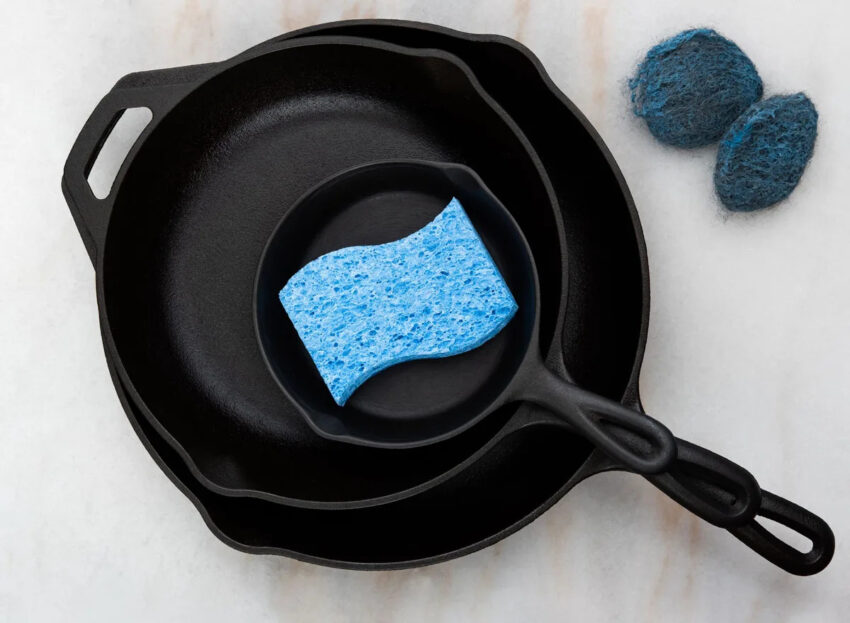Cast iron skillets are essential cookware in any kitchen. They are versatile, durable, and can last a lifetime if properly maintained. However, cleaning cast iron skillets can be intimidating, and many people shy away from using them because they are afraid of ruining them. In this article, we will provide you with a step-by-step guide on how to clean a cast iron skillet like a pro.
Why is Cleaning Cast Iron Skillet Important?

Cleaning cast iron skillets is important to maintain their non-stick surface, prevent rusting, and prolong their lifespan. Cast iron skillets are porous, which means they can absorb flavors and odors from food. If not cleaned properly, the skillet can develop a sticky or rancid residue that can ruin the taste of your food. Moreover, cast iron skillets can rust easily if exposed to moisture, which can also affect the quality of your cooking.
What You Will Need to Clean Cast Iron Skillet
- Hot water
- Mild dish soap
- Plastic scrubber or brush
- Paper towels or clean cloth
- Vegetable oil or other cooking oil
- Aluminum foil
How to Clean Cast Iron Skillet: A Step-by-Step Guide
Step 1: Preheat Your Oven
Preheat your oven to 375°F (190°C) and place your cast iron skillet inside. Let it warm up for about 10-15 minutes. This will help to loosen any stubborn residue and make it easier to clean.
Step 2: Scrape Off the Residue
Using a plastic scraper or spatula, gently scrape off any food residue or bits that are stuck to the skillet. Be careful not to scratch the surface of the skillet.
Step 3: Wash with Hot Water and Soap
Using hot water and mild dish soap, wash the skillet with a plastic scrubber or brush. Do not use steel wool or any abrasive material that can damage the skillet’s surface. Rinse the skillet thoroughly with hot water and dry it with a paper towel or clean cloth.
Step 4: Dry the Skillet
Make sure the skillet is completely dry before storing it. You can dry it on the stove over low heat or in the oven at a low temperature. Alternatively, you can use a clean cloth or paper towel to wipe it dry.
Step 5: Re-Season the Skillet
After cleaning, it is important to re-season the skillet to maintain its non-stick surface and protect it from rusting. To re-season, the skillet, apply a thin layer of vegetable oil or other cooking oil to the surface of the skillet. Make sure to cover the entire surface, including the handle and the edges. Place the skillet upside down in the oven and bake it for about an hour at 375°F (190°C). Once it’s done, turn off the oven and let the skillet cool down before storing it.
Tips and Tricks for Cleaning Cast Iron Skillet
Cleaning a cast iron skillet may seem daunting at first, but it’s actually quite simple. Here are some tips and tricks to help you clean your cast iron skillet like a pro:
Tip 1: Avoid Dishwasher and Harsh Chemicals
Cast iron skillets should never be washed in a dishwasher or with harsh chemicals. This can damage the skillet’s surface and remove its seasoning. Stick to mild dish soap and hot water for cleaning.
Tip 2: Use a Plastic Scrubber or Brush
When cleaning the skillet, use a plastic scrubber or brush to avoid scratching the surface. Steel wool or any abrasive material should be avoided at all costs.
Tip 3: Store the Skillet Properly
After cleaning and seasoning, store your cast iron skillet in a dry place. It’s important to keep it away from moisture to prevent rusting. You can also place a piece of paper towel or cloth inside the skillet to absorb any excess moisture.
Common Myths About Cleaning Cast Iron Skillet
There are several common myths about cleaning cast iron skillets that you should be aware of. Here are some of the most popular ones:
- Myth 1: You should never use soap to clean a cast iron skillet. This is not true. Mild dish soap and hot water can be used to clean the skillet without damaging its surface.
- Myth 2: You should never let water touch the cast iron skillet. This is also not true. While it’s important to dry the skillet thoroughly after washing, a little bit of water won’t hurt the skillet.
- Myth 3: You should never use metal utensils on a cast iron skillet. While it’s true that metal utensils can scratch the surface, it’s not a big deal as long as you don’t use them aggressively.
Conclusion
Cleaning cast iron skillet is a simple process that can be done easily at home. By following the steps outlined in this article, you can keep your cast iron skillet in good condition and ensure that it lasts for years to come. Remember to avoid harsh chemicals and abrasive materials, and always store the skillet properly to prevent rusting.



